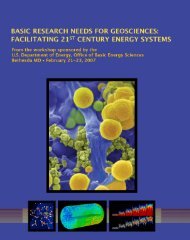Measurement Science Roadmap for Net-Zero Energy Buildings
Measurement Science Roadmap for Net-Zero Energy Buildings
Measurement Science Roadmap for Net-Zero Energy Buildings
- No tags were found...
Create successful ePaper yourself
Turn your PDF publications into a flip-book with our unique Google optimized e-Paper software.
in achieving this goal. Studies have found that, by using currently availabletechnologies, it is possible to reduce a building’s energy consumption by 30 % to 50% (Anderson et al. 2006; Griffith et al. 2007; Levine et al. 2007; USGBC 2007).Existing technologies by themselves, however, will not be adequate to achievedramatic energy reduction goals <strong>for</strong> the buildings sector.<strong>Buildings</strong> are complex systems with many interacting elements. Pastimprovements in the energy per<strong>for</strong>mance of integrated and interacting materials,components, and systems within buildings have not produced the expectedreductions in overall energy use. An integrated portfolio of advanced technologiesis needed that not only supports per<strong>for</strong>mance improvements in the design andmanufacturing of individual components, but also captures the systemcomplexities and interactions seen in real buildings. Additional reductions offrom 20 % to 40 % can be realized by using advanced technologies integratedholistically with the building design (Griffith et al. 2007). Additional energyrequirements, after current and advanced energy saving technologies are in place,must be met through the use of renewable energy systems.The environment in which technologies are deployed must be addressed as well.Challenges include a complex industry and regulatory structure, imperfectin<strong>for</strong>mation, high first costs, technical and market risks, and lack of a trained andexperienced work<strong>for</strong>ce. Technology advances, combined with new policies thataddress or eliminate some of these challenges, will be needed to achieve dramaticimprovements in building energy efficiency.B. Scope and ObjectivesIn 2008, the National <strong>Science</strong> and Technology Council (NSTC) issued the FederalResearch and Development Agenda <strong>for</strong> <strong>Net</strong>-<strong>Zero</strong> <strong>Energy</strong>, High-Per<strong>for</strong>mance Green<strong>Buildings</strong> (NSTC 2008). This landmark report lays out goals <strong>for</strong> achieving dramaticimprovements in building per<strong>for</strong>mance and sustainability. Advances inmeasurement science are cited by the NSTC report as being critical to achievingthe future promise of net-zero energy buildings.In response to the NSTC report and the need to ensure that measurement sciencekeeps pace with the needed technology innovations, the National Institute ofStandards and Technology (NIST) sponsored the <strong>Measurement</strong> <strong>Science</strong> <strong>for</strong> <strong>Net</strong>-<strong>Zero</strong><strong>Energy</strong> <strong>Buildings</strong> Workshop on October 29, 2009 in Gaithersburg, Maryland.Experts from industry, government, national laboratories, and academia (AppendixB) came together to provide insights on the characteristics of the future builtenvironment, the critical technologies and system approaches that would beneeded, and the technical challenges and measurement issues related to net-zeroenergy buildings. Five technical topics were explored, covering both existing andnew buildings:• Onsite <strong>Energy</strong> Production⎯Stand-alone and building-integrated alternativeenergy systems• Intelligent <strong>Buildings</strong>⎯Integrated, intelligent measurement and controltechnologies to improve building environment and functionality• Whole Building Integrated <strong>Energy</strong> Per<strong>for</strong>mance⎯Assessment and projectionof whole building energy per<strong>for</strong>mance2 <strong>Measurement</strong> <strong>Science</strong> <strong>for</strong> <strong>Net</strong>-<strong>Zero</strong> <strong>Energy</strong> <strong>Buildings</strong>
















